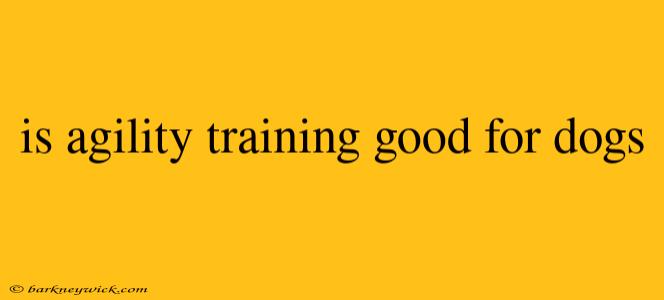Unleashing Your Dog's Inner Athlete: Is Agility Training Right For You?
My dog, a bouncy Border Collie named Scout, is a whirlwind of energy. He's always on the move, exploring every nook and cranny of our house and demanding endless games of fetch. One day, I decided to channel his boundless enthusiasm into something more structured: agility training. Little did I know, this would be the start of an amazing journey for both of us.
More Than Just Fun and Games: The Benefits of Agility Training
While agility training is a fun and engaging activity for dogs, it's so much more than just a game. In my opinion, it's a fantastic way to strengthen the bond between you and your furry friend while promoting physical and mental well-being.
Here's why:
- Physical Fitness: Agility courses challenge dogs to jump, weave, tunnel, and climb, leading to increased muscle mass, cardiovascular fitness, and overall agility. According to the American Kennel Club, regular agility training can help maintain a healthy weight and reduce the risk of age-related health issues in dogs.
- Mental Stimulation: The constant learning, problem-solving, and obedience required in agility training keep dogs mentally engaged and stimulated. Studies conducted by the University of California, Davis have shown that mentally enriched dogs are less prone to anxiety, boredom, and destructive behaviors.
- Bonding: Working together as a team through the challenges of agility training creates a strong and lasting bond between you and your dog. The trust, communication, and mutual understanding that develop can enrich your relationship in countless ways.
- Confidence Boost: As your dog successfully navigates the obstacles, their confidence and self-esteem skyrocket. This is particularly helpful for dogs who are shy, timid, or anxious, as agility training provides a safe and fun environment for them to build their confidence.
Getting Started: Tips for Success
If you're considering introducing agility training to your dog, here are some tips to ensure a positive and enriching experience:
- Start Slowly: Don't overwhelm your dog with complex obstacles right away. Begin with basic commands and gradually introduce new obstacles as they master the previous ones.
- Positive Reinforcement: Use treats, praise, and toys to reward your dog's efforts and encourage them to keep trying. Avoid harsh corrections or punishment, as this can lead to fear and anxiety.
- Consult with Professionals: Consider working with a certified agility trainer who can help you tailor a training program to your dog's breed, age, and physical capabilities. Organizations like the AKC (American Kennel Club) offer resources and training certifications for agility trainers.
- Listen to Your Dog: If your dog seems overwhelmed, frustrated, or tired, take a break and reassess the training session. Agility training should be fun and enjoyable for both of you!
The Power of Perseverance: Our Agility Journey
Scout and I started with basic obstacle courses in our backyard, gradually increasing the difficulty as he progressed. We even joined a local agility club, where we learned from experienced trainers and competed against other dogs. It's been a rewarding experience, witnessing Scout's transformation from a playful puppy into a confident, athletic dog.
The key to success, I've learned, is patience, consistency, and a whole lot of love. Just like any sport, agility training takes time and dedication. But the rewards—the strengthened bond, the improved health and well-being, and the pure joy of seeing your dog thrive—make every moment worthwhile.
So, if you're looking for a fun and rewarding way to connect with your furry friend, consider giving agility training a try. Who knows, you might even unleash a hidden athlete within your own dog!
